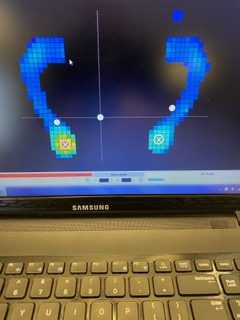Posted with permission from my patient.
This is a 23-year old pro-footballer (right-back/right-footed). C/o: discomfort and severe fatigue in his lower lumbar muscles after only 15-mins steady running. This is a problem for a pro-footballer who is required to be sharp for 90-minutes, over an average 7-9 miles running in a typical game, albeit stop-start speed endurance.
He has much of the morphology of a sprinter: nutated sacrum; naturally anterior pelvis (Innominates: L 18 +ve, R 19+ve = 1 pelvic torsion instance); Quads & Glute max dominant; forefoot equinus with a stable subtalar axes and ankles; forefoot runner; wide powerful shoulders; an excessive 9 of forward lean running 12k/hr on Motion Metrix, etc.
(In the normal innominate orientation, we look for 8-10+ve. Using this as a norm anything higher than 10+ve we call can AS ilium/too anterior, and anything less than 8+ve we call a PI ilium/too posterior).
Px: This guy was extremely powerful in both legs, and very strong in his upper body. Injured players tend to work out their upper body in the club gym while not out on the training field. This patient does exactly that! This can make them too top-heavy in the ‘passenger unit’ creating increased medio-lateral motion of the CoM. This then requires sufficient para spinal strength (erector spinae, quadratus lumborum, multifidus etc.) to stabilise the lumbosacral area.
I will post more detailed explanations regarding pelvic stability and factors required, in future articles.
This athlete was very strong in the legs and upper body but uncharacteristically (for a sprinter) weak in the lumbar paraspinals. This means that running at slow space he runs more heel-to-toe increasing the time:pressure integral per step i.e. ground contact delivers an upward thrust from the power of his legs, with a downward motion of his upper body mass creating tension in the lower back area. Because the core element to his kinetic chain was so weak he cannot control frontal plane pelvic motion increasing forces into the acetabulae. Frontal plane motion of the pelvis is therefore excessive and potentially damaging (see video).
This means that the normal ‘see-saw’ motion of the sacrum in the frontal plane is greatly exaggerated exhausting the paraspinal muscle group. The slower the running speed the greater the ‘see-saw’ affect and the faster the muscle exhaustion. However, at high speed and forefoot running/sprinting this does not occur (as much!) and my patient has no issues during shorter fast bursts in a game.
Because the frontal plane motion of the pelvis is excessive and dominant, other planes of motion are eliminated and the normal but pendular motion of each innominate in the sagittal plane is eliminated creating unnecessary joint moments in the hip joints (greater in this case on the left side due to a moderate leg length inequality – LLI). The sacroiliac joints also require sagittal motion of the innominates to absorb ascending and descending forces, but in this case this is eliminated and creating a heavy gait/strike pattern. This exacerbates the mechanism described above.
Consider the origin (iliac crest) and insertion (transverse process of L1 and lower ribs) of quadratus lumborum and you can appreciate the enormous range the muscle has to control and why it goes into oxygen debt prematurely.
My recommendations and implementation program:
1) Simple polypropylene orthoses with moderate rearfoot control and a small 3mm heel raise the short right leg. Aim was to stabilise the lower limb and increase orthotic reaction forces.
2) S&C program for the core in general but specifically the paraspinals.
3) I have advised this player to stop building his upper body strength i.e. not to increase upper body mass any more than it already is, while wanting to progress his career and reduce overuse injury risk.

